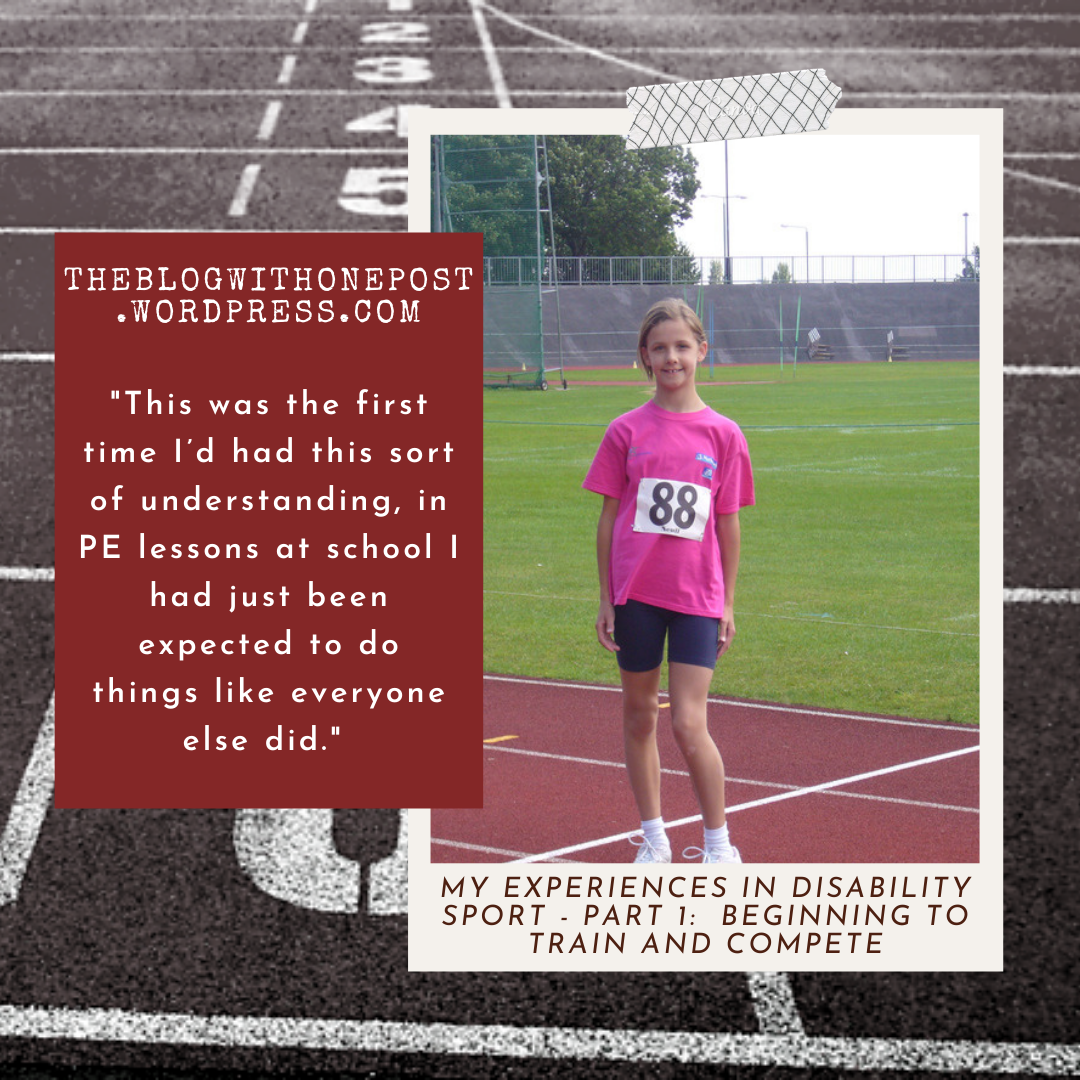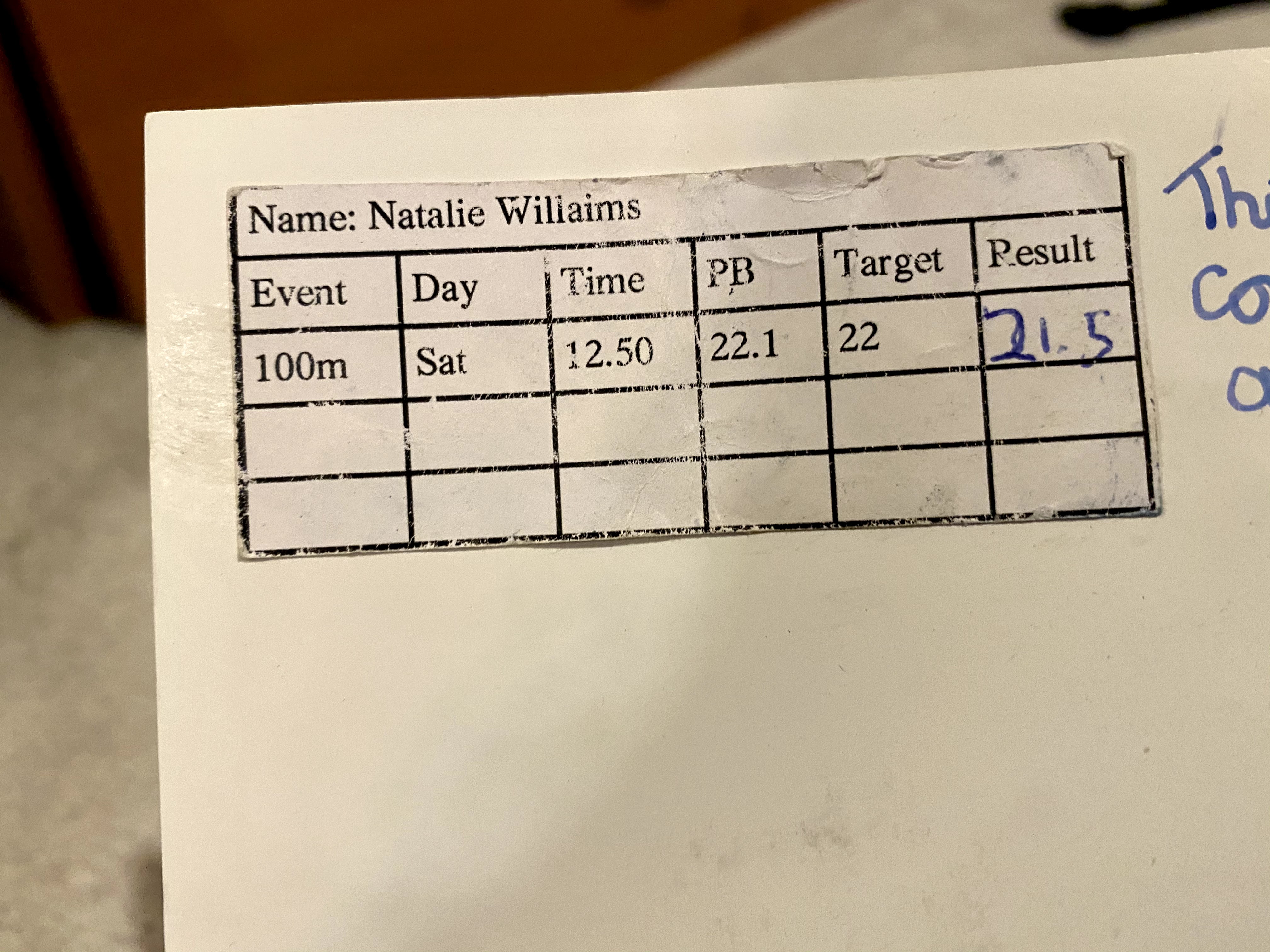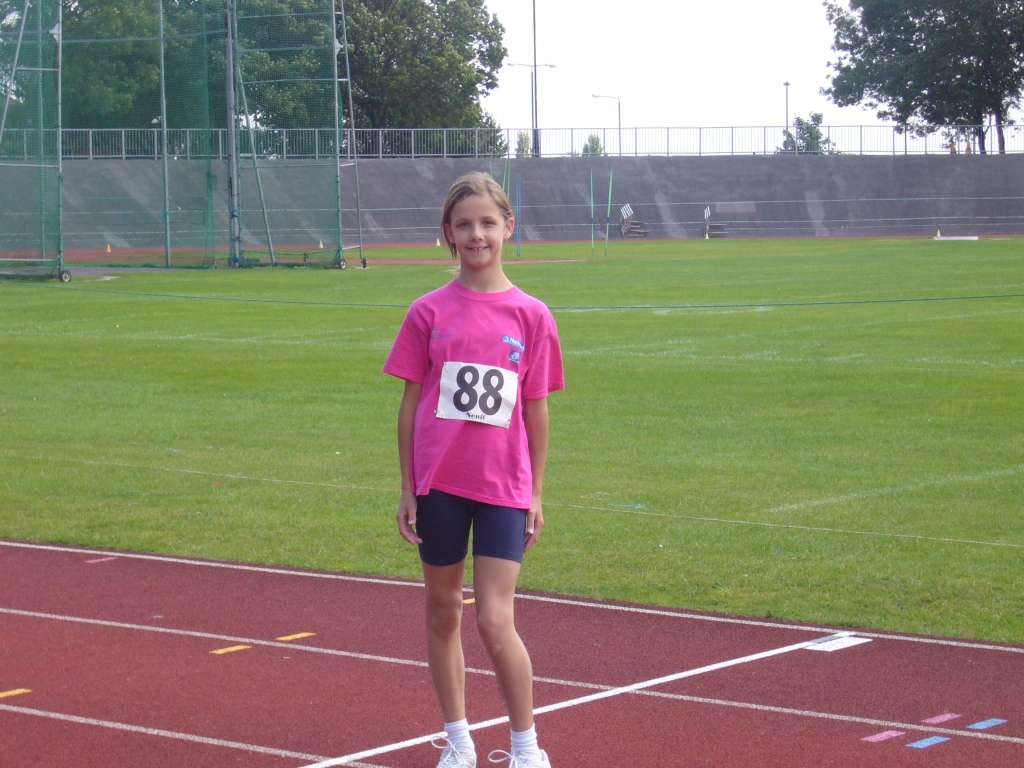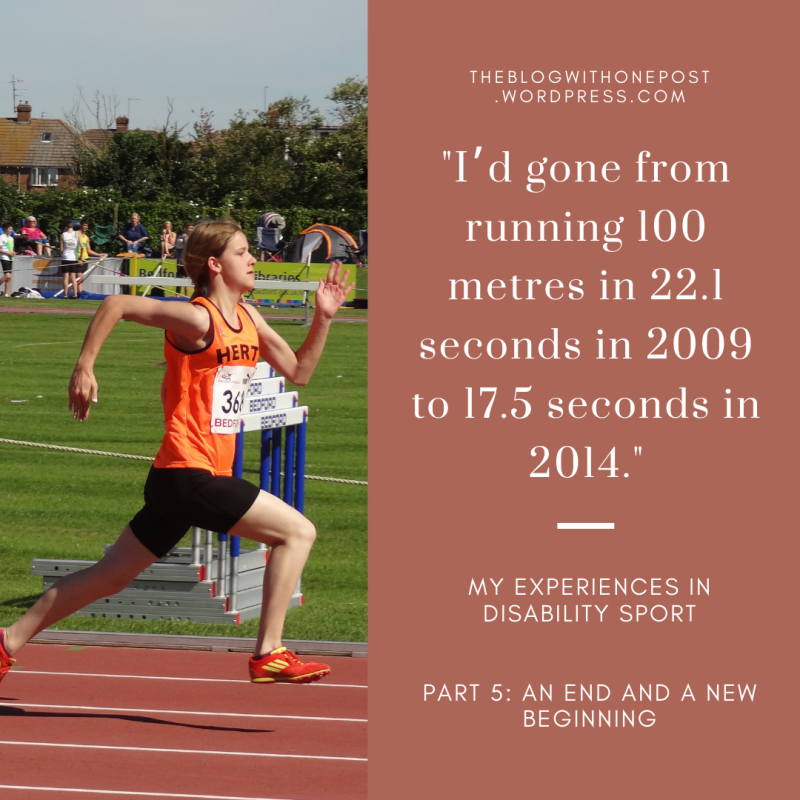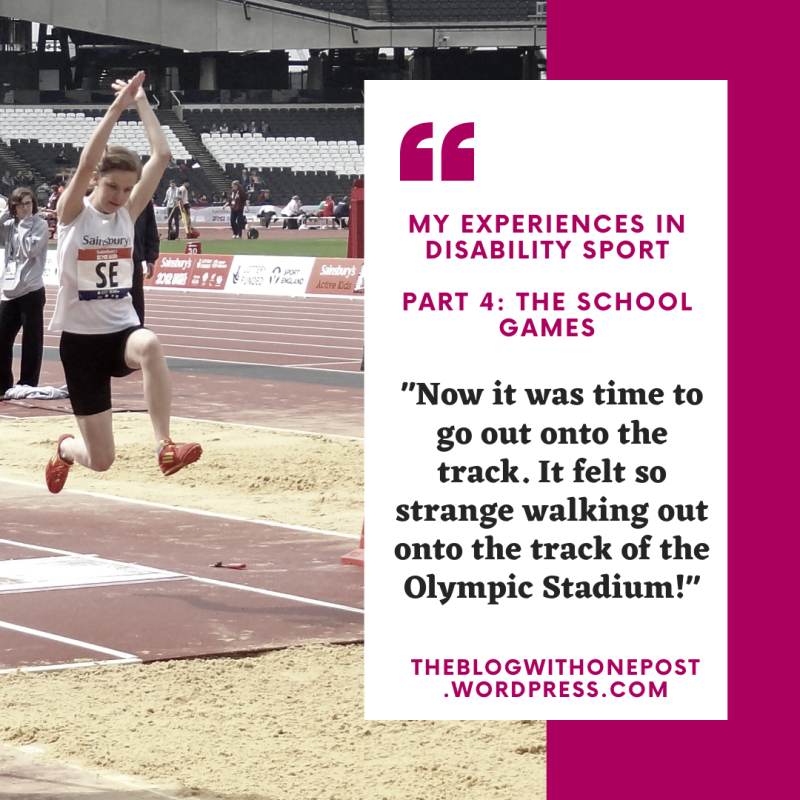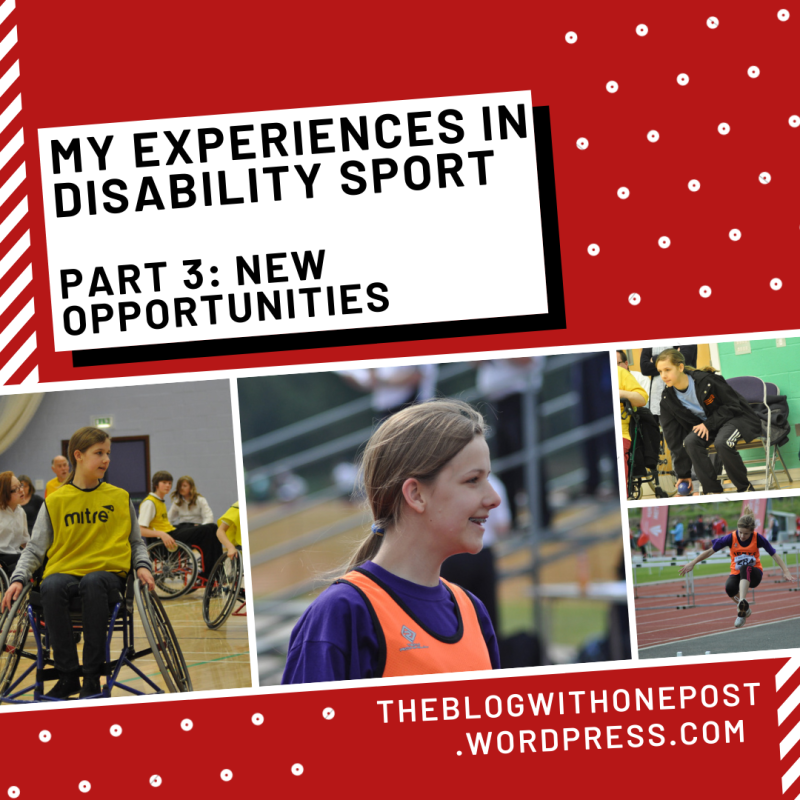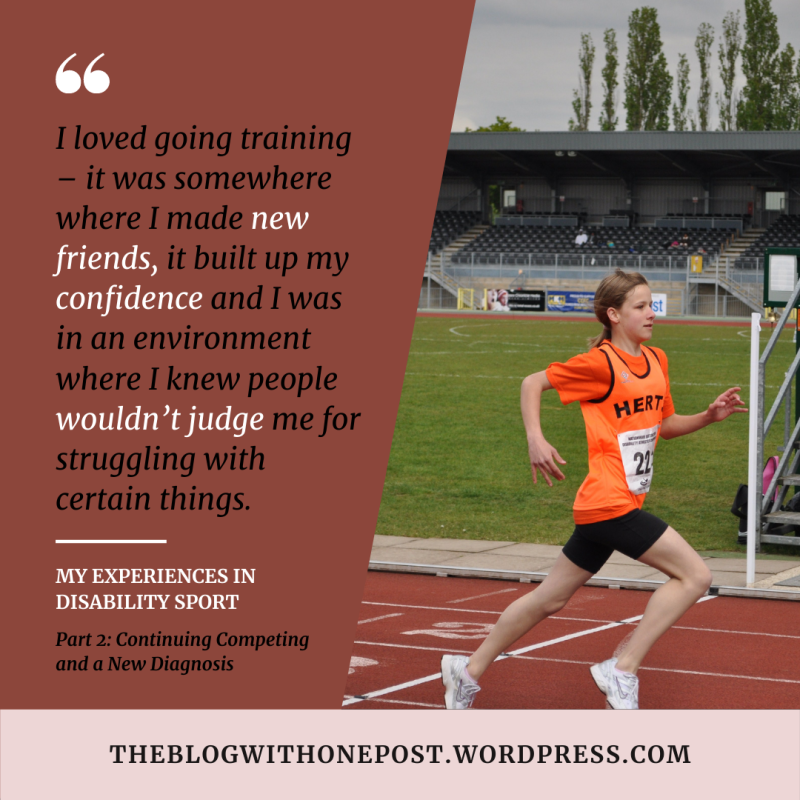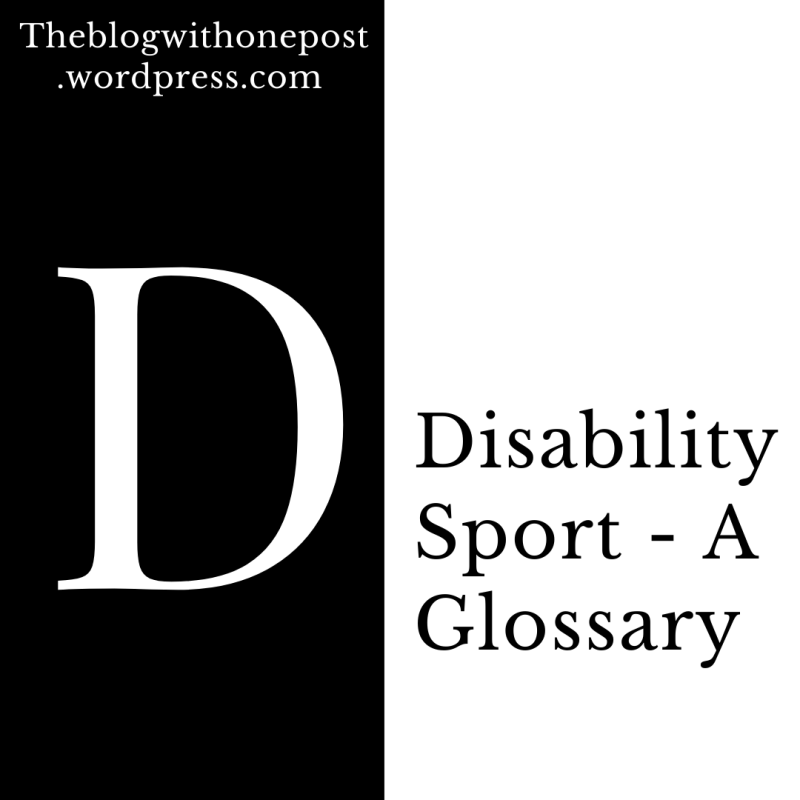Previous posts on disability sport:
During primary school I hated PE. I was slow at getting changed into my PE kit, I was slow at running, I struggled to catch a ball. I did not enjoy sports day at all. I think the expression on my face in this photo sums up what I thought of sports day!
There are so many aspects of dyspraxia which make PE difficult – difficulties with balance, coordination, spatial awareness, motor skills, concentration (I once had a ball hit me on the head due to daydreaming!)
So what would make me want to voluntarily take part in sport? Well, it all started with swimming. When I was in year five we had swimming lessons with school. I was one of about four people in the class who couldn’t swim, so we were in a separate group. These lessons didn’t really help me in learning to swim at all and at the end of year five I received a letter about a scheme called ‘Top Up Swimming’. This was aimed to teach children in primary school to swim. It was run by NHSSP and consisted of free swimming lessons which were run during school holidays. After just over a year of attending this I had eventually learnt to swim!

Whilst I took part in Top Up swimming I met Ros, who was the Partnership Development Manager for NHSSP. Unlike a lot of my experiences at school, Ros was very understanding of my dyspraxia. When I was in year seven, Ros sent an email to my Dad saying that I would be receiving a letter from my school about a disability multi-sports day which was run by her. I received the letter but decided not to go as my experiences in the past had been that sport wasn’t something I enjoyed. However, Ros then mentioned it again to me and my Dad a few months later. I remember my Dad saying to me that Ros had explained that perhaps the reason I didn’t enjoy sport was because I felt that I wasn’t very good at it. This was definitely true. I also seem to remember being surprised that I would be eligible to take part in disability sport. Up until this point I don’t think I had necessarily considered dyspraxia to be a disability. I eventually decided to give disability sports a go in April 2009, when I would have been 11, and joined the disability group within SNHAC (Stevenage & North Herts Athletics Club).
So along I went to my first training session. I was looking forward to it as I knew I would be in an environment where people understood. I’d also been told that there was someone else in the group who had dyspraxia, who happened to go to the same school as me, so that was reassuring to know. Even when taking part in the warm up exercises Ros explained that some of them would be really difficult and encouraged me to take my time with them. This was the first time I’d had this sort of understanding, in PE lessons at school I had just been expected to do things like everyone else did.
It was a couple of weeks into training when I was told about my first competition coming up – the DSE regionals. This seemed like such a big thing at the time, I had never taken part in a competition before – let alone a sports one! I was put down to take part in 60 metres, 100 metres and long jump. Up until this point I had only trained for running, I had never tried long jump before. So I had a few weeks to learn how to long jump!
When it came to the competition, my Dad wasn’t able to come unfortunately as the car had broken down! Luckily we were travelling as a team by coach anyway. My first event of the day was the 60 metres, where I won a gold medal. I remember being so happy at the time – the first medal I’d ever won!
Looking back, I think those of us in the race were all in different classifications so I may have won the medal for being the only one in my classification… but I didn’t know that at the time! I can’t really remember much about the long jump for some reason but I do remember the 100 metres and thinking that it felt like such a long way to run. I remember talking to a couple of people who were taking part in 200 metres and I was shocked as that seemed like such a long distance!
Halfway through the day I had my classification assessment. I completed various tests which assessed balance, coordination and motor skills. As I explained in the glossary, at lower level disability sport competitions individuals with dyspraxia are eligible to be classified. I was classified as a 26 under the DSE profiling system which equates to a T/F36 (although this classification did change later on). I’ve given an overview of the athletics classifications in my previous blog post.
I continued training every Monday evening and in July took part in the DSE nationals competition in Blackpool. What was great about this event was the fact that despite it being a ‘national’ event, there was much more to it than just the competing. It ran across the weekend; we would travel up on the Friday, compete on the Saturday/Sunday and travel back on the Sunday. We stayed in the Hilton Hotel and had a dinner and disco on the Saturday evening. There was also a great friendly team atmosphere to the event, with relays taking place on the Sunday. We were given t-shirts and hoodies; there was a different coloured kit every year and this year’s was bright pink! I only took part in the 100m during the first year – I think that was the only event I qualified for!
I even ran the race with my jogging bottoms still on rather than my shorts – you could definitely tell I was still new to it all! I did win a gold medal though, which I wrote a very enthusiastic facebook post about…
The nationals was an event I continued to take part in each year and it was a weekend I looked forward to every time! Being in such an inclusive atmosphere was lovely. Although I did still find some parts difficult socially. When it came to the dinner on the Saturday evening, we’d be in fairly large groups (around eight of us) sat around one table. When the conversation involved the whole table I was often really quiet, as it’s more difficult for me to keep up with a conversation when it involves quite a few people. I’d often get asked if I was alright, it was nice that people looked out for me but it did make me realise I must have been very quiet!
The next competition I took part in was a few weeks later, the CP Sport nationals. Although I hadn’t been diagnosed with CP (yet), I was able to take part in this competition as a guest. It was just the 60m and 100m I took part in for this event. There was some time when the track wasn’t being used after the event, so I practiced running 200m for the first time. Looking back, I wish I’d kept a proper record of all my times. I have most of them on the Power of 10, but not ones like this! However, I do have the times for the 60m and 100m. In the 60m I got 12.11 and for the 100m I got 20.59. When looking back at the results I also saw that Hannah Cockroft competed at this competition – I obviously didn’t know at the time what a fantastic athlete she would go on to become!
In September I took part in my local club championships. I can’t seem to find the results online, although it is recorded in a results spreadsheet my Dad kept at the time that I competed in shot putt that year, which must have been in that competition. I soon learnt that throwing a heavy weight was not the sport for me! I think this was the only time I did shot putt in a competition and I managed to throw it a whole 3.66 metres (not very far!).
Those four events were the only competitions I took part in during my first year of athletics, not as many as I would go on to take part in in later years but a big contrast to someone who had previously hated sport! In my next post of this series I’ll continue sharing more of my experiences.
Natalie 🙂
Previous posts on disability sport: Disability Sport – A GlossaryDyspraxia and Disability Sport – An Introduction and a Guide to ClassificationMy Experiences in Disability Sport – Part 1: Beginning to Train and CompeteMy Experiences in Disability Sport – Part 2: Continuing Competing and A New DiagnosisMy Experiences in Disability Sport – Part 3: New OpportunitiesMy…
Previous posts on disability sport: Disability Sport – A GlossaryDyspraxia and Disability Sport – An Introduction and a Guide to ClassificationMy Experiences in Disability Sport – Part 1: Beginning to Train and CompeteMy Experiences in Disability Sport – Part 2: Continuing Competing and A New DiagnosisMy Experiences in Disability Sport – Part 3: New Opportunities…
Previous posts on disability sport: Disability Sport – A GlossaryDyspraxia and Disability Sport – An Introduction and a Guide to ClassificationMy Experiences in Disability Sport – Part 1: Beginning to Train and CompeteMy Experiences in Disability Sport – Part 2: Continuing Competing and A New Diagnosis As I mentioned in my previous post, having a…
Previous posts on disability sport: Disability Sport – A GlossaryDyspraxia and Disability Sport – An Introduction and a Guide to ClassificationMy Experiences in Disability Sport – Part 1: Beginning to Train and Compete After finding out that disability sport was something I enjoyed, I continued training during the winter. It did get very cold and…
Previous post on disability sport: Disability Sport – A glossary Sport… something which seemingly involves good balance, coordination, motor skills, and spatial awareness. To some it may sound like a dyspraxic’s worst nightmare! This was the view I had of sport for quite a few years, up until I got into disability sport where the…
In sport there is often a lot of terminology to get your head around and even more so when it comes to disability sport! So I thought I would include a glossary which you can refer to when reading my series of blog posts on disability sport.
